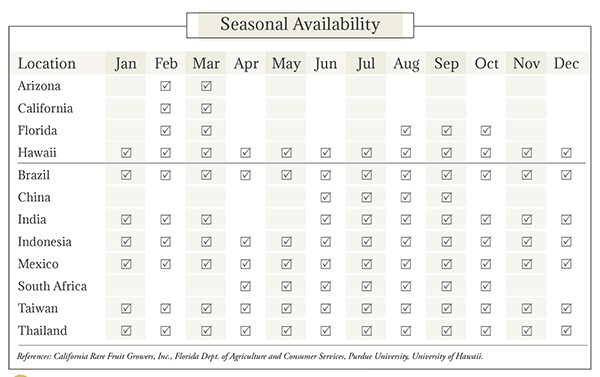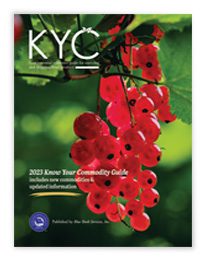Guava Market Summary


Image: Sivonei Pompeo/Shutterstock.com
Guava Market Overview
Psidium guajava, often called “tropical guava” or simply “guava,” is a member of the Myrtle family along with feijoa, jaboticaba, Malay apple, and camu camu. It has been an immensely popular fruit in tropical and subtropical regions throughout the world for centuries and is finally gaining a foothold in other areas, including North America. Though its place of origin is uncertain, scientists believe the fruit came from southern Mexico or Central America, or South America, namely Peru. Spaniard Don Francisco de Paula Marin, who became royal physician and counselor to King Kamehameha, is widely credited with introducing guava to Hawaii in 1791, though scholars believe the fruit was already cultivated on the islands. Guava trees are an important food and wood source, but they have become invasive in Hawaii, overrunning some areas and harming habitats. On the U.S. mainland, guava was brought to Florida’s Miami area from Cuba in the mid-1800s, with the first commercial grove established in the 1910s. The fruit trees have thrived ever since and can now be found throughout southern and central portions of the state, living for up to three or four decades. Portuguese explorers are credited with taking the fruit back to Europe. It eventually made its way to the African continent, where South Africa has become a producer of note. India is far and away the world’s top grower, with Indonesia, China, Mexico, Pakistan, Brazil, and Caribbean countries contributing to supply as well. Although Florida, Hawaii, and California grow guava domestically, most U.S. supply is imported from Mexico or Brazil. Depending on variety, guava flesh is either soft or slightly crunchy when ripe and may be creamy white to dark pink in color. When fully ripe, its thin skin is edible. Most guava is consumed fresh or processed into juice, purees, dried fruit, ice cream, or nutrient powders. Guava is a common ingredient in Indian, Mexican, and Southeast Asian cuisine. Most compare the taste to pineapple, papaya, or bananas, as well as lemons for the more tangy varieties.

Types & Varieties of Guava
Numerous varieties are grown throughout the world, varying in color, flavor, texture, size, and whether or not the fruit has seeds. In some areas, guava trees grow wild, spread by birds. Numerous states in India grow guava, with Maharashtra leading production. With more than two dozen cultivars, some named for their place of origin, Allahabad Safeda, Sardar, and their hybrids continue to dominate production. In South Africa, where orchards were planted in the late 1800s, many guava varieties are named for the growers who originally cultivated them, including Faan Retief, Malberbe, and Rousseau. The pink-fleshed Faan Retief, grown in the Western Cape area, is the most popular and accounts for the vast majority of South Africa’s commercial plantings. Among location-themed monikers are Brazilian/Guinea, China White, Costa Rican, Egyptian Yellow, Giant Vietnamese, Hong Kong Pink, Red Malaysian/Thai Maroon, Sweet White Indonesian, and Taiwan Pink; other colorful varieties include Tropical White and Ruby Supreme. Lemon, Pear, Pineapple (also called feijoa), Pink Acid, and Strawberry and Yellow Strawberry guava varieties are so named due to flavoring. Appearance gave the Yellow Cherry guava its name, due to the fruit’s small size, while apple guavas are known for being seedless. Two of the earliest American-grown guava varieties were the Detwiler and the Redland. The Detwiler originated in Riverside, CA in the early 1900s and was smallish, with greenish-yellow skin, salmon-colored pulp, and a sweet flavor. The Redland, developed in 1941 at the University of Florida in Homestead, was Florida’s ?rst named variety. Unfortunately, it was eventually replaced by other cultivars due to mild ?avoring and susceptibility to algal spotting. Other varieties and hybrids found in the United States and elsewhere include Barbie Pink, Beaumont, Blitch, Chittidar, Crystal, Dhareedar, Hawaiian Red, Hawaiian White, Lalit, Lotus, Mexican Cream (also called Yellow Cream), Mountain, Patillo, Red Indian, Ruby Pink, Ruby X Supreme, Shweta, and Webber.
Cultivation of Guava
Well adapted to subtropical or tropical climes, guava trees thrive in a range of soils. Fruit grows on single or multitrunked trees that can reach up to 20 feet in height. Ideal temperatures range from 73 to 82°F. Temperatures below 60°F may slow growth, and although mature trees can withstand short cold snaps with little damage, young guava trees may be killed by steeply falling temperatures, especially those below 28°F. Similar to apples and pears, guava fruit is round or oval-shaped with green, yellow, or slightly pink skin. Fruit contains small, hard seeds and has a fragrant, flowery aroma and bold flavor, ranging from sweet to slightly tart. Guava trees can bloom year-round, but spring is the primary season. Fruit is ready 90 to 150 days after first bloom, usually in late summer or early fall, depending on growing region. Flowers are primarily pollinated by honeybees. Ripeness indicators include color, aroma, and texture depending on variety though harvest often depends on the intended destination and use of the fruit. Less ripe guava is picked when full-sized and dark to light green in coloring. The firm-yellow stage is better for long-distance shipping, while yellow and soft is only for local markets and fresh consumption.
Pests & Diseases Affecting Guava
Guava tree roots may be attacked by a variety of pests, some of which can be controlled by biological enemies or beneficial insect predators like spiders and lacewings. Others can be managed by sprays and oils and tree maintenance. Microscopic ringworms or nematodes can lead to tree stunting, leaf wilting and yellowing, stem dieback, and ultimately, death of the tree. Mulching, proper fertilization, and watering can help decrease the effects of infestation. In Florida, the Caribbean fruit fly is a common guava pest. Covering young fruit with paper bags until reaching 1-inch in diameter can prevent infestations. Similarly, the use of a paper bag as protection can ward off guava moth larvae, which feed on leaves and tunnel into fruit. Red-banded thrips, both adults and nymphs, are a threat to guava trees. They attack new and mature leaves as well as fruit. After feeding, they leave behind a grey or silvery trail that will eventually turn into dark spots. Leaves may curl and drop, while fruit will have scars and browning of the skin, unsuitable for fresh market sales. Other pests of concern can include aphids, beetles, caterpillars, fire ants, mealybugs, mites, scale insects, thrips, weevils, and whiteflies. Guava is vulnerable to a few diseases, but most can be avoided with preventative measures. Algal spot is characterized by reddish or purplish-brown spots found on leaves. The disease also attacks young fruit and stems, and severe infestations may result in leaf and fruit drop affect tree vigor. Anthracnose is a common fungus and thrives in most humid climates. It attacks young fruit, stems, and leaves. Symptoms include large, irregular dead spots often with pinkish color on leaves and circular brown to black spots on fruit that grow larger over time. Both diseases can be controlled with copper-infused sprays or applications. Pruning to increase light and air movement can also limit severity. More recently, guava wilt disease devastated many guava orchards in South Africa, except for growers in the Western Cape area. Other diseases can include canker, various types of rot, and rust.Storage & Packaging of Guava
Easily bruised, most guava fruit is picked by hand. Some growers do use mechanical tree shakers and nets, especially if fruit is headed to processing. Both ripe and green guava may be stored for 5 to 7 days at 46 to 50°F for mature green and partially ripe guavas, and 41 to 46°F for fully ripe with 90 to 95% relative humidity. References: Agricultural Marketing Resource Center, California Rare Fruit Growers, Inc., Florida Dept. of Agriculture and Consumer Services, Guava Producers Association, Purdue University, University of Florida/IFAS Extension, University of Hawaii.Grades & Good Arrival of Guava
Although there are no published grade standards for guava, USDA notes for inspectors mention proper shape as round, egg or pear shaped; a size of 5 to 6 inches in diameter, skin color as pale yellow with flesh ranging from white or yellow to pink or red; and optimal storage temperatures as not falling below 46°F. Currently, there are no good arrival guidelines published for this commodity.Guava Terminal Market Pricing: 20 lb. Cartons, Large



